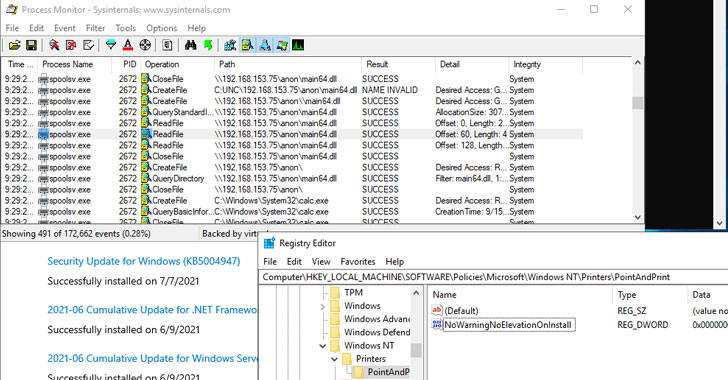Even as Microsoft expanded patches for the so-called PrintNightmare vulnerability for Windows 10 version 1607, Windows Server 2012, and Windows Server 2016, it has come to light that the fix for the remote code execution exploit in the Windows Print Spooler service can be bypassed in certain scenarios, effectively defeating the security protections and permitting attackers to run arbitrary code on infected systems.
On Tuesday, the Windows maker issued an emergency out-of-band update to address CVE-2021-34527 (CVSS score: 8.8) after the flaw was accidentally disclosed by researchers from Hong Kong-based cybersecurity firm Sangfor late last month, at which point it emerged that the issue was different from another bug — tracked as CVE-2021-1675 — that was patched by Microsoft on June 8.
"Several days ago, two security vulnerabilities were found in Microsoft Windows' existing printing mechanism," Yaniv Balmas, head of cyber research at Check Point, told The Hacker News. "These vulnerabilities enable a malicious attacker to gain full control on all windows environments that enable printing."
"These are mostly working stations but, at times, this relates to entire servers that are an integral part of very popular organizational networks. Microsoft classified these vulnerabilities as critical, but when they were published they were able to fix only one of them, leaving the door open for explorations of the second vulnerability," Balmas added.
PrintNightmare stems from bugs in the Windows Print Spooler service, which manages the printing process inside local networks. The main concern with the threat is that non-administrator users had the ability to load their own printer drivers. This has now been rectified.
"After installing this [update] and later Windows updates, users who are not administrators can only install signed print drivers to a print server," Microsoft said, detailing the improvements made to mitigate the risks associated with the flaw. "Administrator credentials will be required to install unsigned printer drivers on a printer server going forward."
Post the update's release, CERT/CC vulnerability analyst Will Dormann cautioned that the patch "only appears to address the Remote Code Execution (RCE via SMB and RPC) variants of the PrintNightmare, and not the Local Privilege Escalation (LPE) variant," thereby allowing attackers to abuse the latter to gain SYSTEM privileges on vulnerable systems.
Now, further testing of the update has revealed that exploits targeting the flaw could bypass the remediations entirely to gain both local privilege escalation and remote code execution. To achieve this, however, a Windows policy called 'Point and Print Restrictions' must be enabled (Computer Configuration\Policies\Administrative Templates\Printers: Point and Print Restrictions), using which malicious printer drivers could be potentially installed.
"Note that the Microsoft update for CVE-2021-34527 does not effectively prevent exploitation of systems where the Point and Print NoWarningNoElevationOnInstall is set to 1," Dormann said Wednesday. Microsoft, for its part, explains in its advisory that "Point and Print is not directly related to this vulnerability, but the technology weakens the local security posture in such a way that exploitation will be possible."
While Microsoft has recommended the nuclear option of stopping and disabling the Print Spooler service, an alternative workaround is to enable security prompts for Point and Print, and limit printer driver installation privileges to administrators alone by configuring the "RestrictDriverInstallationToAdministrators" registry value to prevent regular users from installing printer drivers on a print server.
UPDATE: In response to CERT/CC's report, Microsoft said on Thursday:
"Our investigation has shown that the OOB [out-of-band] security update is working as designed and is effective against the known printer spooling exploits and other public reports collectively being referred to as PrintNightmare. All reports we have investigated have relied on the changing of default registry setting related to Point and Print to an insecure configuration."




























